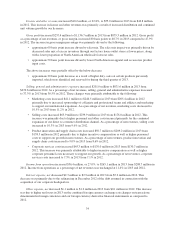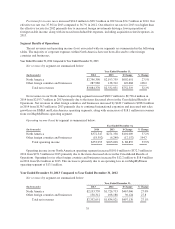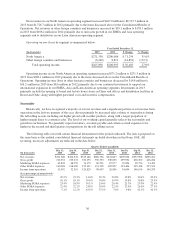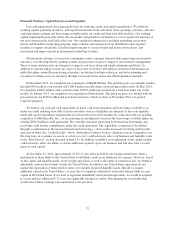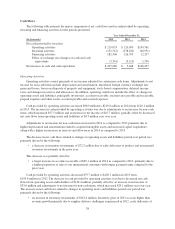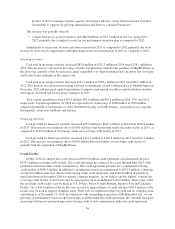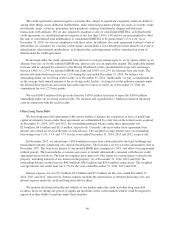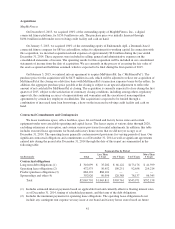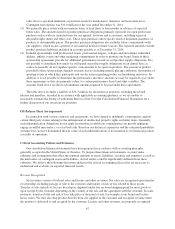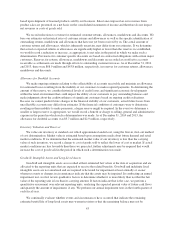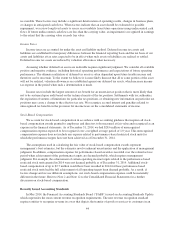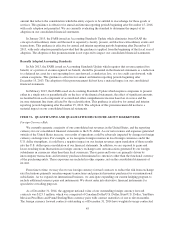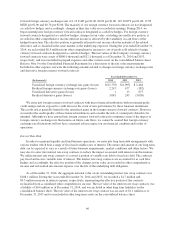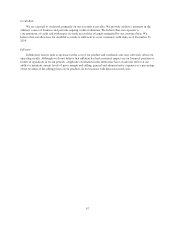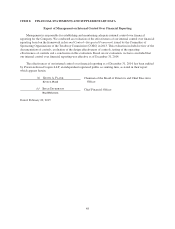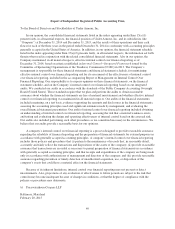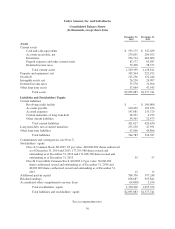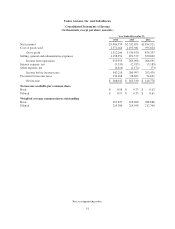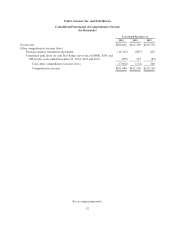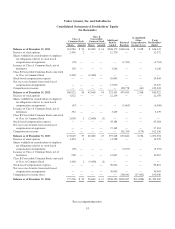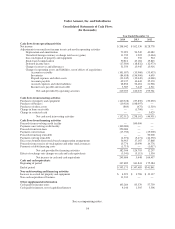Under Armour 2014 Annual Report Download - page 54
Download and view the complete annual report
Please find page 54 of the 2014 Under Armour annual report below. You can navigate through the pages in the report by either clicking on the pages listed below, or by using the keyword search tool below to find specific information within the annual report.r
ecoverable. These factors may include a significant deterioration of operating results, changes in business plans,
o
r changes in anticipated cash flows. When factors indicate that an asset should be evaluated for possibl
e
impairment, we review long-lived assets to assess recoverability from future operations using undiscounted cash
f
lows. If future undiscounted cash flows are less than the carrying value, an impairment is recognized in earning
s
to the extent that the carrying value exceeds fair value.
Income Taxe
s
I
ncome taxes are accounted for under the asset and liability method. Deferred income tax assets an
d
liabilities are established for temporary differences between the financial reporting basis and the tax basis of ou
r
assets and liabilities at tax rates ex
p
ected to be in effect when such assets or liabilities are realized or settled
.
Deferred income tax assets are reduced by valuation allowances when necessary
.
A
ssessing whether deferred tax assets are realizable requires significant judgment. We consider all availabl
e
p
ositive and negative evidence, including historical operating performance and expectations of future operatin
g
p
erformance. The ultimate realization of deferred tax assets is often de
p
endent u
p
on future taxable income an
d
therefore can be uncertain. To the extent we believe it is more likely than not that all or some portion of the asset
will not be realized, valuation allowances are established against our deferred tax assets, which increase incom
e
tax ex
p
ense in the
p
eriod when such a determination is made.
I
ncome taxes include the largest amount of tax benefit for an uncertain tax position that is more likely than
not to be sustained u
p
on audit based on the technical merits of the tax
p
osition. Settlements with tax authorities,
the expiration of statutes of limitations for particular tax positions, or obtaining new information on particular tax
p
ositions may cause a change to the effective tax rate. We recognize accrued interest and penalties related to
unrecognized tax benefits in the provision for income taxes on the consolidated statements of income.
S
tock-Based Com
p
ensatio
n
We account for stock-based compensation in accordance with accounting guidance that requires all stock-
based compensation awards granted to employees and directors to be measured at fair value and recognized as a
n
expense in the financial statements. As of December 31, 2014, we had
$
28.6 million of unrecognized
compensation expense expected to be recognized over a weighted average period of 1.0 year. This unrecognized
compensation expense does not include any expense related to performance-based restricted stock units for
which the performance targets have not been achieved as of December 31, 2014
.
The assumptions used in calculating the fair value of stock-based compensation awards represen
t
management’s best estimates, but the estimates involve inherent uncertainties and the application of managemen
t
j
udgment. In addition, compensation expense for performance-based awards is recorded over the related service
p
eriod when achievement of the performance targets are deemed probable, which requires management
j
udgment. For example, the achievement of certain operating income targets related to the performance-based
r
estricted stock units granted in 2014 were not deemed probable as of December 31, 2014. Additional stock-
based com
p
ensation of u
p
to
$
2.7 million would have been recorded in 2014 for these
p
erformance-base
d
r
estricted stock units had the full achievement of all operating targets been deemed probable. As a result, if
f
actors change and we use different assumptions, our stock-based compensation expense could be materially
different in the future. Refer to Note 2 and Note 12 to the Consolidated Financial Statements for a furthe
r
discussion on stock-based com
p
ensation
.
R
ecently Issued Accounting Standard
s
I
n May 2014, the Financial Accounting Standards Board (“FASB”) issued an Accounting Standards Updat
e
which supersedes the most current revenue recognition requirements. The new revenue recognition standard
r
equires entities to recognize revenue in a way that depicts the transfer of goods or services to customers in an
44


